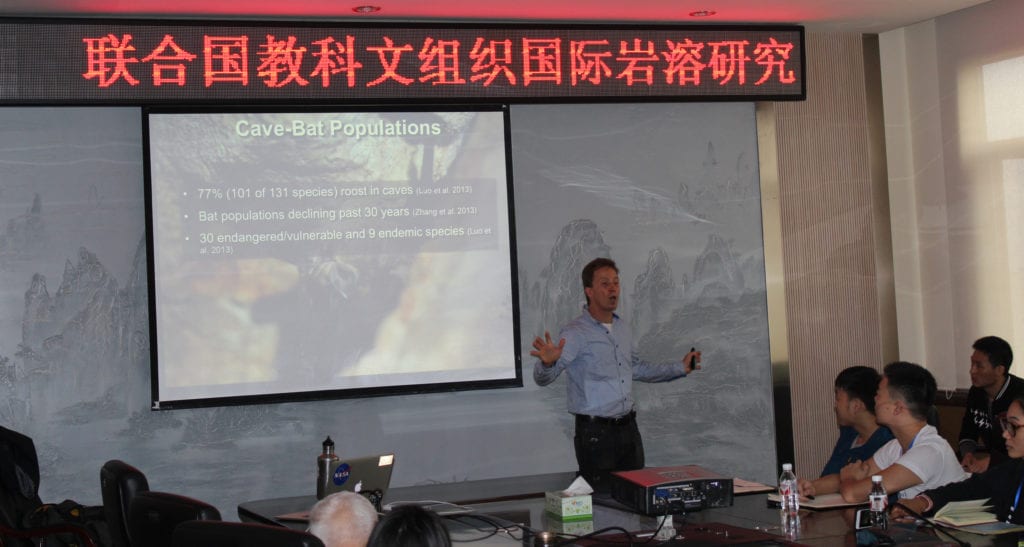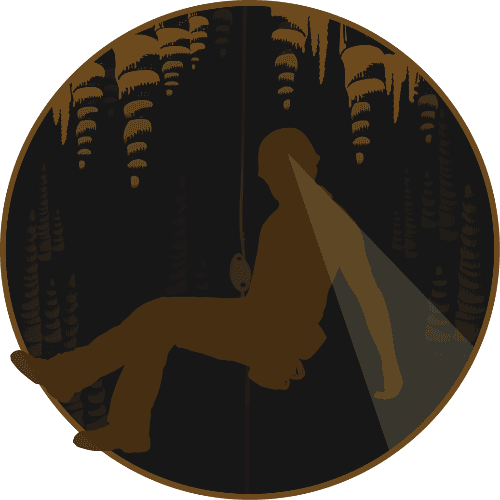
2016 Science on Tap, Flagstaff, Arizona, USA.

Jut is passionate about sharing the importance of scientific exploration and discovery with the general public and children of all ages. One of his goals as a scientist is to convey his knowledge in a way that is entertaining, informative, and inspirational.
He has delivered over 100 public presentations globally including 20 symposia talks (5 invited), 32 university/agency seminars (28 invited), and 50 public presentations (29 invited) in the U.S., Belize, Chile, China, Japan, Polynesia, Spain, England, and Greece (including 14 in Spanish). He was an invited speaker at the 2014 Chicago Ideas Week, a keynote speaker of the 2014 Flagstaff STEM City Awards Celebration, a guest speaker at the 2013 Writers and Illustrators of the Future Awards in Hollywood, CA, an invited speaker at the 2011 National Association of Science Writers conference in Flagstaff, Arizona, and was selected for the Explorers Club flag return as part of the 2009 Explorers Club Annual Dinner in New York, NY.
Jut is a motivational speaker and gives vivid image driven presentations on a variety of topics including:
- The natural history of Easter Island and greater Polynesia;
- The nexus of biodiversity conservation and internationalization of Belize’s rapidly changing landscapes;
- China’s cave ecosystems and the threats of rapid industrialization on native ecosystems;
- Atacama Desert caves and the search for life on Mars;
- The fascinating subterranean world; and,
- Multicultural team leadership and expedition planning.
If you would like to book Jut for a speaking event, please contact him.
Upcoming Talks
Sigma Xi, International Forum on Research Excellence, Long Beach, California (November 11, 2023)
Charleston Darwin Week, College of Charleston and The Citadel, Charleston, South Carolina (February 14, 2024)
Testimonials

“Jut Wynne has been a regular presenter for the Flagstaff Festival of Science. His storytelling easily takes you on a visual journey into the dark and unknown ecosystems of caves, and drives you to be just as passionate as he is about the conservation and protection of the unique organisms that live within.”
Todd Gonzales, Board Member, Flagstaff Festival of Science, Flagstaff, Arizona
“Jut Wynne combines an impressive breadth of knowledge with a contagious enthusiasm to give edge-of-your-seat programs. Audiences of all ages enjoy hearing his tales of exploration and research that focus on cave systems found on both Earth and other worlds.”
Kevin Schindler, Outreach Coordinator (retired), Lowell Observatory, Flagstaff, Arizona
“Jut masterfully shares an authoritative, yet humorous tale of insects, caves and space exploration to an audience captivated by his research, where science fact and fiction become merged.”
Tim Lavery, Director, World Explorers Bureau, Kerry, Ireland
“For our STEM City Awards that included our first art competition, we could not have had a better keynote speaker than Dr. Jut Wynne. He lives his life in the renaissance spirit as an artist and as an accomplished scientist. He pulled from his deep understanding and philosophy of science, combined his vast experiences, and positively impacted and energized the audience with his storytelling and stage presence.”
Zsuzsi Kovacs-Benson, Northern Arizona University, TGen North, Flagstaff, Arizona
Public Lectures
2020
Global Biodiversity Festival (virtual seminar). Going deep! Cave biodiversity.
Museum of Northern Arizona, Colton Seminar Series, Flagstaff, AZ (virtual seminar). Addressing knowledge shortfalls in subterranean ecology (invited).
Science on Tap, Flagstaff, AZ. Bat and cave conservation in the new Maya Forest Corridor, Belize (invited).
2019
Flagstaff Festival of Science, Flagstaff, AZ. Finding caves on Earth and future robotic and human exploration of Mars.
Highlands Center for Natural History, Prescott, AZ. Cave ecology of the Grand Canyon region.
2018
Royal Geographical Society of Hong Kong, Hong Kong. Terrestrial cave detection and future robotic and human exploration of Mars (invited).
Flagstaff Festival of Science, Flagstaff, AZ. Caves, contaminants, and environmental change in China (invited).
The Explorers Club, New York, NY. Caves, contamination, and environmental reform in China (invited).
2017
Sociedad Excursionista de Málaga, Málaga, Spain. Los insectos endémicos y hábitats relictos de Rapa Nui (invited).
Science on Tap, Flagstaff, AZ. Caves, contamination, and China.
2016
Brunswick-Glynn County Library, Brunswick, GA. The bizarre cave animals of Guangxi, China.
Museo Nacional de Historia Natural, Santiago, Chile. Los insectos endémicos y hábitats antiguos de Rapa Nui.
Museo Antropológico Padre Sebastián Englert, Rapa Nui. Inventario, conservación y manejo de los insectos endémicos de Rapa Nui (invited).
Explora Hotel, Rapa Nui. Conservación y gestión de las cuevas y biología de cueva en Rapa Nui (Isla de Pascua; invited).
Science on Tap, Flagstaff, AZ. The race to save the endemic insects of Easter Island.
Brunswick-Glynn County Library, Brunswick, GA. Cave life of the greater Grand Canyon.
2015
Bishop Museum, Honolulu, HI. New discoveries and novel ideas from Rapa Nui caves.
Explorers Connect, London, England. New discoveries and novel ideas from Rapa Nui caves.
The Explorers Club, New York, NY. Discoveries from Rapa Nui caves: New species and novel ideas.
Arizona Science Center, Phoenix, AZ. Arizona cave biology.
2014
Chicago Ideas Week, Chicago, IL. Colonizing the caves of Mars (invited).
Science on Tap, Flagstaff, AZ. Cave life of the greater Grand Canyon (invited).
Southern California Chapter, The Explorers Club, San Diego, CA. The mysteries of Easter Island caves (invited).
Atlanta Chapter, The Explorers Club, Atlanta, GA. The mysteries of Easter Island caves (invited).
Science Café, Bookman’s Entertainment Exchange, Flagstaff, AZ. Roundtable discussion on research on Rapa Nui (Easter Island).
World Explorers Bureau, Beyond the Podium Series, Celebrity Cruises (roundtrip San Juan, Puerto Rico to Barbados). Three Presentations: (1) The mysteries of Easter Islands caves; (2) Cave life of the Greater Grand Canyon, and (3) Cave detection on Earth and Mars (invited).
2013
Science on Tap, Flagstaff, AZ. The mysteries of Easter Island caves.
National Speleological Society Webinar Series. The mysteries of Easter Island’s caves (invited).
2012
Flagstaff Festival of Science, Flagstaff, AZ. The biology and archaeology of Easter Island caves.
2011
Museo Antropológico Padre Sebastián Englert, Easter Island. Las cuevas de Rapa Nui y implicaciones para la conservación y manejo (invited).
Brunswick-Glynn County Library, Brunswick, GA. The archaeology and ecology of Easter Island caves.
EarthWatch Institute, Easter Island, Chile. The caves of Rapa Nui and implications for conservation and management (invited).
Patagonia (Store), Las Condes, Santiago, Chile, Las cuevas de Rapa Nui.
National Association of Science Writers, 2011 Annual Meeting, Flagstaff, AZ. Covering a lot of (Under)Ground: Cave ecology on Earth and caves on Mars (invited).
Sierra Club, Grand Canyon Chapter, Flagstaff, AZ. Cave life of the Greater Grand Canyon (invited).
Explorers Club, Southwest Chapter Lecture Series, Flagstaff, AZ. The ecology and archaeology of Easter Island caves.
2010
Flagstaff Festival of Science, Science in the Park, Flagstaff, AZ. Discussed the importance of caves, cave-dwelling arthropods and bats, as well as caving ethics and the fragility of cave resources with the general public.
Bishop Museum, Honolulu, HI. Bishop Museum and Sigma Xi Seminar Series. Biological and cultural resource investigations of Rapa Nui (invited).
2009
Museo Antropológico Padre Sebastián Englert, Rapa Nui. Resultados preliminar: Natural y cultural historia de las cuevas de Rapa Nui (invited).
Explorers Club Headquarters, New York City, NY. Flag Expedition Presentation, 104th Explorers Club Annual Dinner Weekend, Sunday Lecture Series. Cave biodiversity inventories on North Rim Grand Canyon and Rapa Nui, Chile (invited).
2008
Flagstaff Festival of Science, Flagstaff, AZ. Caves on Earth and Mars: The search for life.
Lowell Observatory, Flagstaff, AZ. Thermal detection of caves on Earth and cave-like structures on Mars.
2007
Three Rivers Regional Library Lecture Series, Brunswick, GA. Thermal detection of caves on Earth and cave-like structures on Mars.
Flagstaff Festival of Science, Science in the Park, Flagstaff, AZ. Caves, cave-dwelling arthropods and bats and the importance of conserving these fragile places.
Lowell Observatory, Flagstaff, AZ. If there’s life, it’s underground! The search for caves on Mars (invited).
2006
The Mission Gallery and Coffee House, Grants, NM. Astrobiology and the search for Martian cave life.
Flagstaff Festival of Science, Flagstaff, AZ. Astrobiology and the search for Martian cave life.
Flagstaff Cultural Partners Annual Fundraiser, Flagstaff, AZ. Cave-adaptation and cave-dwelling animals of Arizona and Belize.
USGS-Flagstaff Field Center Monthly Lecture Series, Flagstaff, AZ. Sensitive ecological areas and species inventory of Actun Chapat, Vaca Plateau, Belize (invited).
University, Museum, & Agency Seminars

2020
Northern Arizona University, School of Earth and Sustainability, Flagstaff, AZ. Addressing knowledge shortfalls in subterranean biology (invited).
2019
SUNY-Cortland, Cortland, NY. Cave and bat conservation in the new Maya Forest Corridor, Belize (invited).
2018
Tohoku University, Department of Engineering and Space Robotics, Sendai, Japan. Terrestrial cave detection and future robotic and human exploration of caves on Mars (invited).
Tohoku University, Department of Geosciences, Sendai, Japan. Terrestrial cave detection and future robotic and human exploration of caves on Mars (invited).
Hebei University, College of Life Sciences, Baoding, China. Towards an iterative vulnerability assessment of cave biota: South China Karst, a case study (invited).
Xishuangbanna Tropical Botanical Gardens, Xishuangbanna, China. Towards an iterative vulnerability assessment of cave biota: South China Karst, a case study (invited).
International Research Center on Karst, Guilin, China. International Training Course on Karst Ecological Geology and Karst Landform. Towards an iterative vulnerability assessment of cave biota: South China Karst, a case study (invited).
SUNY-Cortland, Cortland, NY. Caves, contamination, and environmental reform in China (invited).
2017
Museo Nacional de Ciences Naturales, Madrid, Spain. Los insectos endémicos y hábitats relictos de Rapa Nui (invited).
University of the Aegean, Mytilini, Lesvos, Greece. Detecting caves on Earth and the Future of cave exploration on other planets (invited).
SUNY-Cortland, Cortland, NY. Inventory, conservation, and management of endemic insects of Easter Island (invited).
2016
China University of Geosciences at Wuhan, Department of Environmental Studies, Hubei, China. Human induced environmental change and the effects on cave ecosystems: A China case study (invited).
China Geological Survey, Wuhan Center, Wuhan, Hubei, China. Terrestrial cave detection: Advancing the technology in southern China (invited).
China Geological Survey, Wuhan Center, Wuhan, Hubei, China. Human induced environmental change and the effects on cave ecosystems: A China case study (invited).
Southwest University, Department of Geographical Sciences and Karst Environment Laboratory, Chongqing, China. Human induced environmental change and the effects on cave ecosystems (invited).
International Research Center on Karst Training Course, Guilin, Guangxi, China. Preliminary results: Troglobite inventory and contaminant sampling of Guilin Caves, Guangxi, China (invited).
International Research Center on Karst Training Course, Guilin, China. Human induced environmental change and the effects on cave ecosystems (invited).
Parque Nacional Rapa Nui, CONAF, Easter Island. Inventario, conservación y manejo de los insectos endémicos de Rapa Nui (invited).
Parque Nacional Rapa Nui, CONAF, Easter Island. La carrera para salvar los insectos endémicos de Rapa Nui (invited).
SUNY-Cortland, Cortland, NY. The race to save the endemic insects of Easter Island (invited).
2015
Japanese Aerospace Exploration Agency (JAXA), Planetary Caves Research Group, Sagamihara, Japan. Terrestrial cave detection: Implications for planetary cave exploration and human habitation (invited).
U.S. Fish and Wildlife Service, Pacific Islands Fish and Wildlife Office, Honolulu, HI. Conservation and management of cave arthropods on Rapa Nui (invited).
Northern Arizona Bat Working Group, Flagstaff, AZ. Bat hibernacula of northern Arizona (invited).
Instituto Geológico y Minero de España, Madrid, Spain. Robotic exploration and human habitation of Martian caves (invited).
2014
San Diego State University, Department of Biology, San Diego, CA. Disturbance relicts in a changing world: The Rapa Nui factor.
Armstrong State University, Department of Biology, Savannah, GA. The mysteries of Easter Island caves.
Georgia Southern University, Statesboro, GA. The mysteries of Easter Island caves (invited).
2013
Coconino Community College, Flagstaff, AZ. The mysteries of Easter Island caves (invited).
2011
Parque Nacional Rapa Nui, CONAF, Easter Island, Chile. Implicaciones para la conservación y manejo de las cuevas en Rapa Nui (invited).
Universidad de Los Andes, Santiago, Chile. Detección de las cavernas en los Desiertos de Atacama y Mojave: Terrenos análogos a Marte (invited).
Museo Mirador de la Biodiversidad, Monumento Natural La Portada, Antofagasta, Chile. Cuevas del Cordillera de la Sal, Una analogía para Marte (invited).
Universidad Católica del Norte, Centro de Biotecnología, Antofagasta, Chile. Las cavernas del Desierto de Atacama, una analogía para Marte (invited).
2009
Hawaii Volcanoes National Park, National Park Service, Volcano, HI. Biological and cultural resources of Easter Island caves (invited).
2008
Pontificia Universidad Católica de Chile, Facultad de Ciencias Biológicas, Departamento de Genética Molecular y Microbiología, Santiago, Chile. On Detecting caves on Earth and cave-like structures on Mars (invited).
